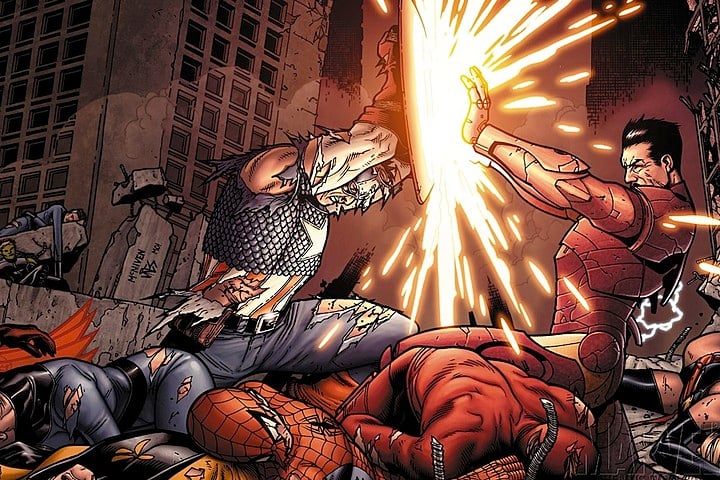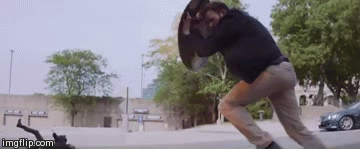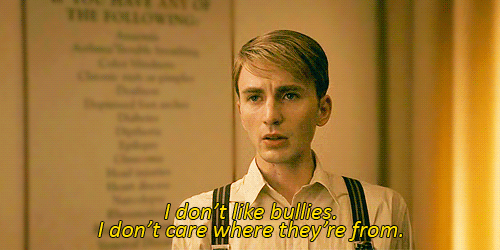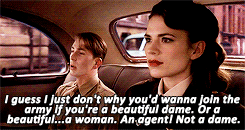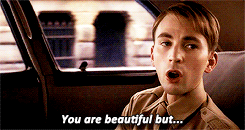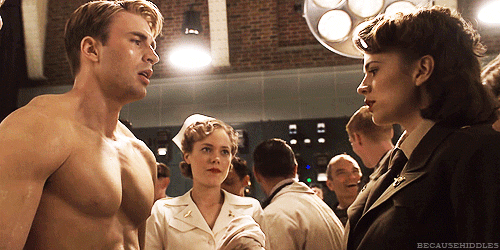This article contains spoilers for comics in the Civil War arc of Captain America, so if you haven’t read that arc and you want to remain potentially unspoiled for the upcoming film, maybe don’t read this one!
We talk a lot about what’s expected of girls, right from the time they’re born. We give them pink, frilly things to wear, and the toys they play with can often be seen as either feminized versions of male toys or items designed to fully domesticate or even fetishize young girlhood. These issues are important, difficult, and a huge reason why I became a feminist in the first place—to smash through those walls holding the patriarchy aloft—but we don’t talk nearly as much about the ways in which we teach our boys to become “men” through what Salon calls a “crushing socialization.” These issues should be just as important to feminists, for toxic masculinity is one of the bricks that seal up those patriarchal walls.
Due to the societal pressure to be more masculine, men are three times more likely than women to have rage issues, and depression is diagnosed far more often in women than in men because men tend to hide their depression under workaholic tendencies or a mask of indifference. In the aforementioned Salon article, Terry Real is quoted saying, “Ten years of difference in longevity between men and women turns out to have little to do with genes. Men die early because they do not take care of themselves. Men wait longer to acknowledge that they are sick, take longer to get help, and once they get treatment do not comply with it as well as women do.”
In short, the American concept of masculinity is killing our men and forcing them into gender biases that are causing them to rage, destroy, kill others (90.5% of murders are perpetrated by men) or themselves.
I know, I know. Get to Captain America already. What does Captain America have to do with any of this?
Captain America not only navigates masculinity, but he completely subverts and ultimately rejects our contemporary conceptions of what it means to be a man, thereby creating a new kind of masculinity that demands self-inquiry, emotional empathy, and innate goodness. It’s not enough to just say Cap is an example of non-toxic masculinity, because what Cap does is redefine the binary of maleness. He’s not just an emblem for what not to be; he’s a roadmap of masculine possibility. One could argue that this point of view of Steve Rogers can be easily explained by his origin in the 1940s. This argument, while valid, is not the totality of Steve Rogers, nor of Captain America. I’ll be using images, themes, and objects related to Cap as a way of showing how Steve’s behavior pre and post serum can be used as a lens to redefine how we view manhood.
Note: For the backstory, I’ll be going straight to the origin stories from the comic, but for the dialogue, images, and behavior of Steve Rogers, I’ll be culling from the Marvel Movie Universe, as the image of Steve Rogers as portrayed by Chris Evans serves to highlight the rejection of toxic masculinity and the creation of a new form of manhood.
Steve, The Art Student
Many of the male, human Avengers specialize in math and sciences: Tony Stark is a brilliant electric engineer, and Bruce Banner holds a doctorate in nuclear physics. But prior to getting transformed into Captain America, Steve Rogers was an art student who was really into comics and illustration and was planning on getting fine arts degree. This focus on the humanities correlates to Steve already subverting our expectations. We think of Captain America as this beefcake who represents the best of us. Perhaps the “best of us” doesn’t have to always focus on STEM (although the push for more women and girls to get involved and recognized for their work in math and science disciplines is welcome), but on the ways in which we can discuss, theorize, and imagine the world, as well, through arts education. This major literally illustrates Steve’s optimism and hope and points out a reason why Steve would volunteer for Operation Rebirth in the first place. He sees the world how it could be, which leads him to ultimately transform into Captain America.
This new form of seeing the world can also apply to his shield. Captain America has a shield, made out of vibranium, from the country of Wakanda. (Yaaaaaas, Black Panther!) While the shield can also be used as an attack object, it is mostly used to cover and protect not only himself, but others. It is not a phallic object like Thor’s Mjolnir. It’s a thoroughly yonic object, a slightly concave and feminine shape. This represents Captain America’s humanity, almost maternal nature, and the urge to protect before throwing blows.
A New Superman
In several interviews, Chris Evans has joked Cap isn’t a very exciting superhero, stating, “He’s just a really good guy. Sometimes I feel like he has no business being in this crew. Thor’s calling down lightning, and I’m just like ‘I’ll take the stairs!’” I would argue Cap’s innate goodness and humility makes him a very welcome anomaly in the world of the Avengers. In the film Captain America: The First Avenger, Abraham Erskine tests Steve Rogers to see if he’s worthy of taking on the super serum of Operation Rebirth. By asking Steve “Do you want to kill Nazis?” Erskine is testing the goodness and humanity of Steve, rather than his aggression. Given the opportunity to display a violent, aggressive personality in order to receive the super serum training, Steve goes the other way.
This point of view coming out of a superhero seems slightly surprising, given that we just had a Batman v Superman film in which Superman commits millions of dollars in collateral damage without much regard for consequence. On my Twitter feed, I saw a few people bemoaning the lack of a true Superman film, in which Superman was the beacon of light in a world of darkness. While I urge all of them to go back and watch the original Christopher Reeve Superman movies, I also urge them to watch Captain America. Steve Rogers, in a way, is our new Superman, because of his innate goodness and urge to protect those around him.
Later, when Steve asks Erskine why he was chosen for the project, Erskine confirms this test of his goodness: “The serum amplifies everything inside, so good becomes great, bad becomes worse. This is why you were chosen. Because the strong man who has known power all his life, may lose respect for that power, but a weak man knows the value of strength, and knows … compassion.” Steve was chosen not because he was a good soldier, but because he was a good person. Erskine closes his speech by exhorting Steve to remain “a good man” as well as a super soldier.
I also want to point out a connection between Steve’s masculinity and his progressive politics. Steve’s main reason for wanting to join the Army is not because he wants to blow shit up, but because he’s sickened by Hitler’s regime. It can be be argued that despite the general tendency to view Cap as a neo-conservative, hypermasculine patriot in the #MURICA vein, Steve Rogers grew up with the New Deal, in Brooklyn, and therefore probably would be more of a liberal-minded fellow, as well as being what Steve Attewell calls “explicitly anti-fascist.” Also, see my earlier point about his liberal arts education. Recently, there has been an effort to paint Cap as more of a nationalist, but I like to think that, post-Iraq, there’s been a concerted effort to keep Captain America as a defender of the small against the mighty. There was actually a cut scene from The Avengers in which Steve Rogers bemoaned, amongst other things, the contemporary lack of universal health care. How’s that for a progressivist hero?
Steve and Sexuality
It’s stated multiple times in the first Captain America film that Steve, pre-serum, has a lot of issues with girls and doesn’t really know how to talk to them. It’s heavily implied that he’s still a virgin.
After Operation Rebirth, Steve Rogers transforms from frail weakling to physical “perfection.” Annnnnd cue gratuitous .gifs.
Post-serum, Steve is at the societal ideal of physical beauty and strength. He can rip logs in half, and according to the new Civil War trailer, he can hold onto a helicopter with one hand and the lip of a building with another. He’s also frequently accosted by women who openly flirt with him because of his heroic exploits and Adonis-like figure, and his response is not to go for it and start doing every girl he sees, but rather, he reacts with total and utter confusion. His one great romance in The First Avenger abruptly ends when he sacrifices himself for the sake of a mission. Winter Soldier gives him some opportunities for flirtation and a kiss with Natasha for the sake of a cover-up (and he does mention that he’s “95 but not dead”), but that’s about it. Heck, the first thing he does after getting the serum is to chase down a bad guy.
In interviews, Chris Evans has suggested that Steve is still a virgin, due to the allusions to his less-than-successful flirting history. I feel this is important to underline: One of the most successful installments of the Avengers franchise concerns a superbly buff, handsome man who is supposed to represent everything good about America, and he’s completely a failboat when trying to talk to women and is sexually inexperienced. At the same time, Cap isn’t focusing his energies on women or getting action in bed. He’s trying to figure out how the world can be better and how to engage in this new kind of warfare. I feel there’s something to be learned from this scenario, too, about Steve’s physical transformation—it’s just that: physical. It’s not going to automatically up his sexual experience nor his confidence with women. (Chris Evans also states in that above interview he was positive Steve was waiting for Peggy Carter. HE HAD A DATE.)
Doing the Right Thing
Steve Rogers is about doing the right thing for the good of civilians. This is exemplified in the Civil War comic book arc, when Cap and Iron Man find themselves on vastly different sides of the Superhero Registration Act. Both sides are fundamentally right with good points. Tony Stark argues that it’s only reasonable that superheroes undergo training and registration in order to keep them accounted for, and Steve Rogers argues that a public database of superheroes would ruin their chances of a “normal” family life. Both sides behave badly, with Cap sucker-punching Iron Man in front of a large crowd after secretly disabling his suit. This conflict escalates until Cap, on the verge of delivering a finishing blow to Iron Man, realizes that civilian personnel are the ones trying to hold him back from hurting Tony further. This realization—that civilians are on Iron Man’s side and want the superheroes to be put into a register—shocks Steve, and he starts to understand that perhaps the other side’s point is for the good of the people he’s supposed to protect. This goes back to his training in the ’40s as a soldier in the last “good war.” Steve doesn’t finish off Iron Man; rather, he surrenders, because he feels it’s the right thing to do.
When going to the courthouse to be arraigned, Steve Rogers is assassinated by a hypnotised Sharon Carter. This act triggers a shockwave throughout the superhero world, and Bucky takes on the mantle of Captain America after receiving a posthumous letter from Steve urging him to take the shield. Of course, this being the comic book world, Steve is quickly brought back to life, but he does not reclaim his shield. Instead, he lets Bucky keep it. Then, when Bucky resumes his role as the Winter Soldier, Steve gives the shield to Sam, aka Falcon. I find this all to be very important, because it would be very easy for Steve to come back and just be like, “That’s mine again!” Steve is a man of his word. Currently, plans are in place for Steve Rogers to return to his role as Cap, but without his shield, as he gave it to Sam. According to series writer Nick Spencer, “[W]e’ll have two Captain Americas. When Steve handed the shield to Sam, it didn’t come with any caveats. It’s his. Steve respects and admires what his old partner is doing and wants him to carry on.” He could have easily come back in and grabbed it, but he didn’t.
I’m from the Judith Butler school of thought that gender is socially constructed; indeed, I take it as a given, and masculinity as a gender role can be devastating to the social and cultural landscape, not only to men, but to women as well. It impacts people of all ethnicities and economic backgrounds. Men are angry, they are depressed, and they are killing themselves for not measuring up to an impossible ideal. While Captain America’s physical body is, of course, an impossible ideal, he is more than just his look. This focus on doing the right thing, on being kind, on searching for the truth, on being smart, and on being “a good man” creates in the depiction of Steve Rogers a new type of manhood, one that we could all benefit from learning from.
Alysa Auriemma is a teacher, writer, activist, geek, cosplayer, and her friend group’s feminist killjoy. Her blog, The Curious Ally Cat, has seen notice by newspapers such as the Hartford Courant and the New York Times. She is in the process of writing a series of fantasy novels for self-publication. In her spare time, she enjoys participating in community theater, solo trips to the city to see Broadway shows, really good Mexican food, and arguing with friends about which Mighty Ducks movie is the best (D2).
—The Mary Sue has a strict comment policy that forbids, but is not limited to, personal insults toward anyone, hate speech, and trolling.—
Follow The Mary Sue on Twitter, Facebook, Tumblr, Pinterest, & Google+.



